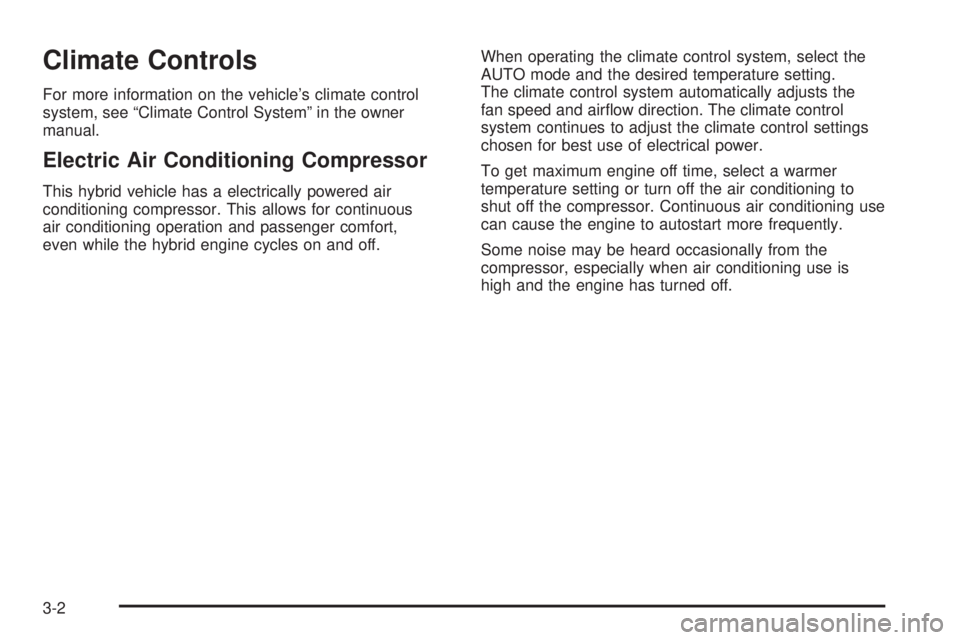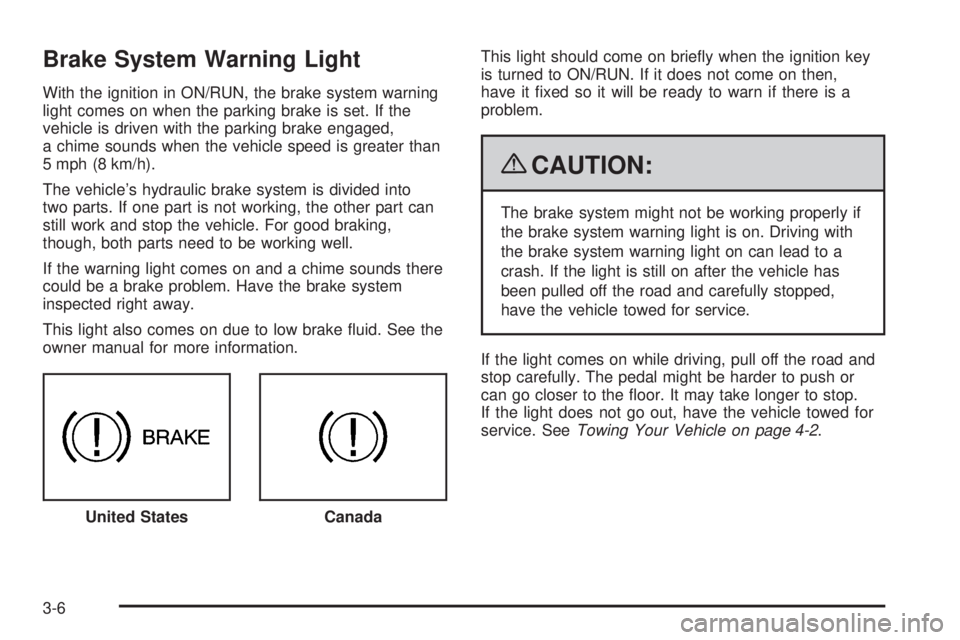Page 17 of 94

Range Selection Mode
The Range Selection Mode controls the vehicle’s
transmission.
To use this feature:
1. Move the shift lever to the M (Manual Mode).
2. Press the plus/minus button, to upshift or downshift
selecting the desired range of gears.
A number displays next to the M, indicating the current
gear that has been selected. The number displayed in
the gear indicator is the highest gear that can be used.The vehicle can automatically shift to lower gears as it
adjusts to driving conditions. When 3 (Third) is selected,
1 (First) through 3 (Third) gears are automatically shifted
by the vehicle, but 4 (Fourth) cannot be used until it is
selected.
The Range Selection Mode controls the vehicle and
engine speed while driving down a hill or towing a trailer,
by allowing you to select a desired range of gears.
When you move the shift lever into M, the transmission
will default to M4. In this gear range, effective engine
braking occurs at speeds above 45 mph (72 km/h).
Pushing the minus (−) button on the shift lever reduces
the gear range.
In the M3 gear range, effective engine braking occurs at
speeds above 35 mph (56 km/h).
In the M2 gear range, effective engine braking occurs at
speeds above 25 mph (40 km/h).
In the M1 gear range, effective engine braking occurs at
speeds above 10 mph (16 km/h).
When operating in M (Manual Mode), Auto Stop is
disabled. For better vehicle efficiency, operate the
vehicle in D (Drive) not M (Manual Mode).
Cruise control can be used while using the Range
Selection Mode.
2-9
Page 18 of 94

Regenerative Braking
Regenerative braking is a hybrid technology that
enables the electric drive motor to operate as a
generator when coasting or braking. Energy from the
moving vehicle recharges the hybrid battery.
The hydraulic disc brakes work with the regenerative
braking to insure effective braking, such as when a high
braking demand is requested.
The braking system is computer controlled and blends
the regenerative braking with the conventional hydraulic
disc brakes to meet any requirements for deceleration.
The controller interprets the braking request and uses
regenerative braking, conventional hydraulic braking or
a combination of both as necessary. Because the
controller applies the hydraulic brakes through its high
pressure accumulator, you may occasionally hear
the motor driven pump when it recharges the system.
This is normal.
See “Warning Lights, Gages, and Indicators” and “Driver
Information Center (DIC)” in the Index of the owner
manual. In the event of a controller problem, the brake
pedal may be harder to push and the stopping
distance may be longer.
Running the Vehicle While Parked
It is better not to park with the engine running. But if you
ever have to, here are some things to know.
{CAUTION:
Exiting the vehicle, without first shifting into
P (Park), may cause the vehicle to move, and you
or others can be seriously injured. Because the
vehicle has the Automatic Engine Start/Stop
feature, the vehicle’s engine might seem to be
shut off when you come to a complete stop.
However, once the brake pedal is released, the
vehicle can move. The vehicle’s engine can also
restart at any time.
Shift to P (Park) and turn the ignition to
LOCK/OFF, before exiting the vehicle.
Follow the proper steps to be sure the vehicle will not
move. See “Shifting Into Park” in the owner manual
for more information.
If pulling a trailer, seeTowing a Trailer on page 4-2for
more information.
2-10
Page 19 of 94

Climate Controls..............................................3-2
Warning Lights, Gages, and Indicators..............3-3
Instrument Panel Cluster.................................3-3
Tachometer...................................................3-4
Charging System Light....................................3-4
Fuel Economy Gage.......................................3-5
Brake System Warning Light............................3-6
Antilock Brake System (ABS) Warning Light.......3-7
StabiliTrak
®Indicator Light...............................3-7Engine Coolant Temperature Gage...................3-8
Oil Pressure Gage..........................................3-8
Oil Pressure Light.........................................3-10
Fuel Gage...................................................3-11
Driver Information Center (DIC).......................3-12
DIC Warnings and Messages.........................3-12
Audio System(s).............................................3-14
Navigation/Radio System...............................3-14
Section 3 Instrument Panel
3-1
Page 20 of 94

Climate Controls
For more information on the vehicle’s climate control
system, see “Climate Control System” in the owner
manual.
Electric Air Conditioning Compressor
This hybrid vehicle has a electrically powered air
conditioning compressor. This allows for continuous
air conditioning operation and passenger comfort,
even while the hybrid engine cycles on and off.When operating the climate control system, select the
AUTO mode and the desired temperature setting.
The climate control system automatically adjusts the
fan speed and airflow direction. The climate control
system continues to adjust the climate control settings
chosen for best use of electrical power.
To get maximum engine off time, select a warmer
temperature setting or turn off the air conditioning to
shut off the compressor. Continuous air conditioning use
can cause the engine to autostart more frequently.
Some noise may be heard occasionally from the
compressor, especially when air conditioning use is
high and the engine has turned off.
3-2
Page 21 of 94
Warning Lights, Gages, and Indicators
Instrument Panel Cluster
The instrument cluster is designed to show at a glance how the vehicle is running. It indicates how fast the vehicle is
going, about how much fuel is left, and many other things needed to drive safely and economically.United States version shown, Canada similar
3-3
Page 22 of 94

Tachometer
When the gas engine is off and the key is in the
ON/RUN position, the position of the tachometer
indicator shows the state of the vehicle:
•AUTO STOP position indicates that the vehicle is
still able to move and the engine could restart,
by an Auto Start, at any time.
•OFF position indicates that the engine is off.
When the engine is on, the tachometer indicator shows
the engine’s revolutions per minute (rpm).
Charging System Light
This light will come on
briefly when the
ignition is turned to
ACC/ACCESSORY or
ON/RUN, but the engine is
not running, as a check
to show it is working.
It should go out once the engine has been started. If it
stays on, or comes on while driving, there could be
a problem with the charging system. A charging system
Driver Information Center (DIC) message may also
appear. SeeDIC Warnings and Messages on page 3-12
for more information. This light could indicate that
there are electrical problems. Have it checked right
away. If a short distance must be driven with the light
on, be certain to turn off all the accessories, such as the
radio and air conditioner. United States Version
shown, Canada similar
3-4
Page 23 of 94
Fuel Economy Gage
This gage shows when the vehicle is operating at a
fuel efficient point.By modifying driving behavior to increase the
economy time during driving, fuel mileage will be
improved. When driving in a way that increases the
fuel economy, the indicator moves into the high
efficiency band. When driving in a way that decreases
fuel economy, the indicator moves into the less
efficient band. There are several zones on the gage,
indicating several levels of efficiency when accelerating
or decelerating.
United States
Canada
3-5
Page 24 of 94

Brake System Warning Light
With the ignition in ON/RUN, the brake system warning
light comes on when the parking brake is set. If the
vehicle is driven with the parking brake engaged,
a chime sounds when the vehicle speed is greater than
5 mph (8 km/h).
The vehicle’s hydraulic brake system is divided into
two parts. If one part is not working, the other part can
still work and stop the vehicle. For good braking,
though, both parts need to be working well.
If the warning light comes on and a chime sounds there
could be a brake problem. Have the brake system
inspected right away.
This light also comes on due to low brake fluid. See the
owner manual for more information.This light should come on briefly when the ignition key
is turned to ON/RUN. If it does not come on then,
have it fixed so it will be ready to warn if there is a
problem.
{CAUTION:
The brake system might not be working properly if
the brake system warning light is on. Driving with
the brake system warning light on can lead to a
crash. If the light is still on after the vehicle has
been pulled off the road and carefully stopped,
have the vehicle towed for service.
If the light comes on while driving, pull off the road and
stop carefully. The pedal might be harder to push or
can go closer to the floor. It may take longer to stop.
If the light does not go out, have the vehicle towed for
service. SeeTowing Your Vehicle on page 4-2.
United States
Canada
3-6